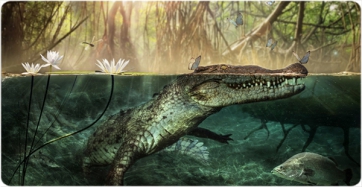ICP News
Thesis defenses in times of pandemic: Joan Femenias and his PhD work on the Eocene primate Agerinia
09 Sep 2020
542 times
Joan Femenias, researcher at the Paleoprimatology and Paleoanthropology Group of the Institut Català de Paleontologia Miquel Crusafont (ICP), defended his doctoral PhD thesis on this small 50-million-years-old primate of about. The analyzed fossil remains were obtained from the ICP collections as well as from prospecting and sampling campaigns in the…
A new study led by Albert Prieto-Marquez, ‘Ramón y Cajal’ researcher at the Institut Català de Paleontologia Miquel Crusafont (ICP) sheds light on how the iconic frill of the ceratopsians (a group that includes the well-known three-horned Triceratops) evolved through the 65 million years of existence of these animals. The…
The extinct African crocodile species Crocodylus checchiai may be closely related to American crocodile species alive today, according to a study published in Scientific Reports. The findings suggest that crocodiles may have migrated from Africa to America during the Late Miocene epoch (11–5 million years ago). The research has been…
Following the recommendations of the health authorities linked to the COVID-19 pandemic and with the aim of limiting contagions and to facilitate conciliation with the personal/family life of the staff due to the closure of educational centers, the ICP Museum is closed and all the public activities have been canceled…
A new study led by researchers from the Institut Català de Paleontologia Miquel Crusafont (ICP) reveals that the morphology of the inner ear’s bony labyrinth is a powerful tool to reconstruct phylogenetic relationships among apes and humans. By means of a recently developed technique of 3D geometric morphometric analysis, researchers…
On the occasion of International Women's and Girl's Day in Science, which is celebrated on February 11, the women working at the Institut Català de Paleontologia Miquel Crusafont (ICP) explain their jobs.
The Institut Català de Paleontologia Miquel Crusafont (ICP) participates in a European Training Network (PUSHH) led by the University of Copenhagen (Denmark) that aims to provide international doctoral training to study the evolution of the human lineage through the analysis of ancient proteins from tooth enamel.
The navicular bone of Anchomomys provides new clues about its locomotion behavior
23 Jan 2020
746 times
A research team from the Institut Català de Paleontologia Miquel Crusafont (ICP) analyzes the navicular bone of the small primate Anchomomys frontanyensis, a species described in Sant Jaume de Frontanyà (Berguedà, Catalunya) in 2011. The morphology of this fossil remains suggest that this species would be more agile than other…
The director of the Institut de Biologia Evolutiva (IBE, CISC-UPF), ICREA research professor and associate researcher at the Institut Català de Paleontologia Miquel Crusafont (ICP) has obtained a Consolidator Grant from the European Research Council (ERC). The researcher will receive a grant of 1.896.875 euros to carry out, over five…
An international team of paleontologists including Borja Holgado and Fabio M. Dalla Vecchia, associate researchers at the Institut Català de Paleontologia Miquel Crusafont (ICP), has described a new genus and species of pterosaur, Mimodactylus libanensis. It is based on the most complete skeleton of these extinct animals ever discovered from…
















